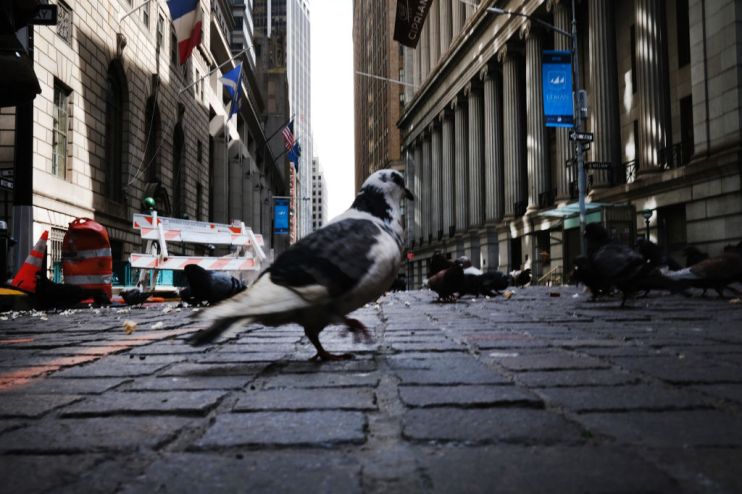There is a difference between helicopter money and quantitative easing

Many investors have it wrong. This round of central bank alchemy starring Jay Powell is not Ben Bernanke the Redux…
Yes, on both occasions central bankers rode in on their white horses and saved the day by slashing rates, buying fixed income securities, flattening volatility and offering bazooka style forward guidance, and for that they deserve a cigar. But, there are some key differences upon which to reflect.
During the global financial crisis (GFC), the Federal Reserve used those monetary bazookas to backstop the financial system, inflate asset prices and prevent a super-spike in unemployment (which if left unmanaged could have triggered the next Great Depression). The US government initially resisted these measures.
Read more: Sunak shifts towards emergency loans
This time around, with encouragement from the White House, it is about stabilising financial markets as well as opening the door to directly jump-starting demand, because, consumption is about to take a nose dive and the forthcoming earnings season is about to prove it.
But hang on a second, the Fed (the 800lb gorilla of central banks), is independent and has a clear mandate of maximum employment and price stability, not consumption targeting.
This is the reason why the lines between central banks and governments are about to get very blurry, and investors would be remiss to ignore the subtleties around and differences between quantitative easing (QE) and helicopter money (HM).
Put simply, if QE is the unconventional, then HM is the unconventional on rocket fuel (n.b. I make no distinction between helicopters taking off and debt-monetisation in this article, which will undoubtedly annoy some academics).
After the GFC, Fed Chairperson Ben Bernanke (unfairly referred to as “Helicopter Ben”) did not really print money. QE is but a maturity transformation exercise where central banks buy fixed income securities in the open market and exchange it for cash. This cash is then credited to the reserve accounts (held at the Fed) of the financial institution selling the securities.
In this scenario, the printing presses are not fired up, but rather liquidity is created, and interest rates are suppressed (both extremely welcomed results in their own right). Don’t believe me? If QE were about printing money then the money supply would have exploded to the upside after the GFC, potentially creating an inflationary shock, but this did not materialise. It was the monetary base that increased dramatically due in part to the fact that commercial banks horded this newly created liquidity as opposed to creating more loans (as evidenced by the increase in excess reserves held at the Fed). Hence one of the reasons why hyperinflation did not manifest itself is because money supply grew at a normal rate and the currency was not ‘debased’ (also the velocity of money remained low). So, how does money ‘get printed’? It is the commercial banks which magically create money by issuing new loans, which are then credited to bank accounts for further spending or investment by borrowing clients.
Helicopter money is fundamentally different to QE in that there is no exchange of assets. It is merely a one-way forgivable transfer. In a stylised example, if the government were to issue bonds which the central banks buy (and cancel) in order for the government to issue cheques, which would then be deposited in bank accounts for citizens to spend – that would equate to the Fed directly targeting consumption. We are not there yet, but this is the direction we are now moving towards.
As US unemployment spikes above 17%, perhaps helicopter money is not a bad idea in the States, but there is a reason why Bank of England officials were adamant that the newly activated overdraft with the UK government was temporary; if exercises such as this become permanent, longer-term central bank independence may be at risk.
At risk of what, you ask? Assuming developed market governments start dictating to central banks the quantum of bonds and the rate at which they must be acquired, what is stopping them from going further and dictating the level at which interest rates are set? This would then make it impossible for central banks to maintain their independence and have the ability to take away the punchbowl when the party starts to get out of hand. Isn’t that the real job of a central banker, to curb irrational exuberance?
If the US government really wanted to take it to the next level, they could issue ‘corona-only’ vouchers directly to citizens under a certain income threshold, which would be redeemable only at consumer outlets (for instance retailers and leisure businesses). This would help to guarantee demand is actually created because, if you were just made redundant, with unemployment hitting 17% and you were to get a cheque in the post, would you really go out and buy a flashy new TV set or the latest pair of Ray Bans for that forthcoming beach holiday? Or would you hold back some of that helicopter cash for a rainy day? That is why the vouchers should be targeted and carry an expiry date. Furthermore, this would have to be a one-off monetary measure and the Fed would need to decide all the terms under zero political pressure.
QE is past its sell by date, and I can hear the helicopters coming. The flight path plays into the hands of politicians who would like to wrestle control of monetary policy away from the Fed. Furthermore, the fact that many investors are not aware of the seemingly subtle (but actually stark) differences between QE and helicopter money could put them at a disadvantage. In this fog of war, if central banks lose their independence, then government bond investors might stop making money, which means you will probably be better off holding corporate bonds instead.